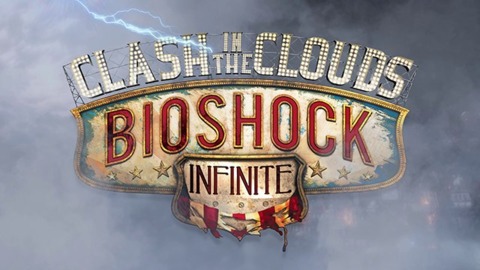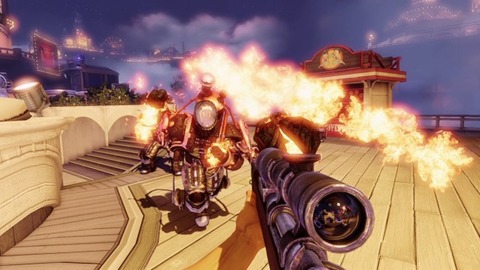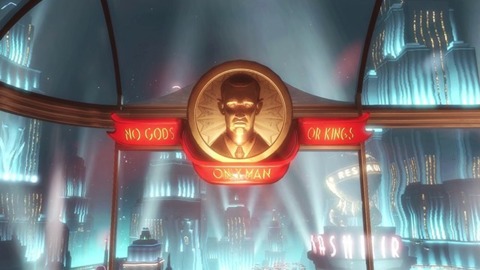Designing BioShock Infinite: Two Sides to Every Coin
Irrational Games' lead level designer, Forrest Dowling, discusses BioShock Infinite's downloadable content, and the balance of narrative and combat.
BioShock Infinite is special for many reasons, but its success can be distilled down to two factors: its captivating story and the playful mix of firearms and superpowers in combat. In theory, the two worked in unison; the citizens of Columbia drew you in with open arms, only to turn against you in a flash. In that instant, you went from new kid on the block to public enemy number one, fighting for survival at every turn.
Kingdom Come: Deliverance 2 - Official Cinematic Announcement Trailer Stellar Blade - BIBI ‘Eve’ Official Music Video Trailer | PS5 Apex Legends: Urban Assault Collection Event Trailer Total War: WARHAMMER III - Elspeth von Draken Gameplay Showcase Genshin Impact - "Arlecchino: Sleep in Peace" | Official Character Teaser Potionomics: Masterwork Edition - Official Announcement Trailer Snowbreak: Containment Zone - "Gradient of Souls" Version Trailer Harold Halibut GameSpot Video Review Nancy Drew: Mystery of the Seven Keys | World Premiere Official Trailer Modern Warfare III & Warzone - Official Cheech & Chong Bundle Gameplay Trailer SteamWorld Heist II – Official Reveal Gameplay Trailer Dead Island 2 – Official SoLA Expansion Gameplay Launch Trailer
Please enter your date of birth to view this video
By clicking 'enter', you agree to GameSpot's
Terms of Use and Privacy Policy
In reality, not all players and critics felt the balance of narrative and combat was copacetic. Ars Technica editor Peter Bright deftly summarized the relationship between BioShock Infinite's gameplay and story telling in his op-ed, The Failure of BioShock Infinite: Writing Games Like Movies, "The technology and gameplay are not the raison d'être of BioShock Infinite. They're simply an enabling backdrop, providing the tools to create characters and a narrative."
When lead level designer Forrest Dowling began brainstorming ideas for BioShock Infinite downloadable content, it didn't take long for him to come up with what we now know as Clash in the Clouds, a horde mode with four original maps and unlockable extras. The question is: when a game is primarily heralded for its narrative, is more gunplay what fans want? Time will tell, but Dowling is confident that, despite the narrative-vs.-combat debate, Clash in the Clouds has an audience.

We recently sat down with Dowling to discuss his history at Irrational Games, BioShock Infinite's development, and what it has been like to not only conceive and create Clash in the Clouds, but to have a hand in the reimagining of Rapture for the upcoming Burial at Sea DLC.
How did you get involved with Irrational Games?
Dowling: Right place at the right time. I was working at a place down in New York. They got in touch with me because they were looking for designers, and it kind of just worked out.
Whose idea was it to create combat-focused DLC?
Dowling: That was me. So basically, we finished BioShock Infinite, and I was one of the last content people off the boat. I was like, "All right, now we have to start working on DLC. What are we going to do for it?" I just fired up the editor and tried doing this combat thing to see how it worked. So I built a prototype over the course of a week, then I shopped it around the studio to see what people thought, and I got the green light to do it. Ken played it and had fun with it. People saw the potential, so I was able to put together a little team and build it.
You were responsible for the opening scene in Columbia, right?
Dowling: Yeah, I was the lead from when the rocket touches down in the cathedral through to when you reach Monument Island.
How has it been for you to switch to combat-focused design?
Dowling: Refreshing! I think that one of the reasons why a lot of people like the job of level designer is that you have so many different responsibilities at different times. That is definitely true at a place like Irrational, where sometimes it's the level designer's responsibility to properly tease a narrative over time, and sometimes it's just to make kick-ass combat. So much of the time I spent on BioShock Infinite was making sure voice-over lines trigger at the right time, or when a piece of freight passes over, it's just the best moment. Being able to step back and say "Now my job is to see if it's fun to fight three firemen and a handy man" is different, but also rewarding in a different way.

One of the greatest discussions around BioShock Infinite is the connection between combat and narrative. Was there ever a moment when someone at the studio felt apprehensive about focusing too much on combat? Is it a given, for a game that people want to see more of, that this is a natural way to do that?
Dowling: I wouldn't say it's given as a game, but BioShock is a game that people play for a couple different reasons. Some people are really interested in the story, some are really interested in the gameplay, and some are in between. As a gamer, I tend to be of that ilk. And you know, Clash in the Clouds, we knew it wasn't going to be for 100 percent of the people out there. It was going to be for people who are really into the gameplay experience, and that's what they wanted more of.
I think I went into it with open eyes. I'm certainly aware of all the conversations that are going on around it, but at the same time, I also saw that there were a lot of people who reacted very positively to the combat and the gameplay and the simplest stuff, like 1999 mode. I thought that there would be a sizable group of our fans who would really be into this sort of experience. Ultimately, it's up to them to let me know if I was right or not.
The people driving these discussions rarely said there was anything wrong with the gameplay; it was just in juxtaposition…
Dowling: Yeah, I think obviously Clash in the Clouds is immune to that, because there is no juxtaposition. We're not really trying to justify it in any sort of fictional context within the world. Right from the get-go, I got the green light to say this is a meta-experience. It is not part of the BioShock story; it is just for fun.
It does contribute in part to the lore of the world, right?
Dowling: The [new] voxaphone stuff was mostly because we can't control ourselves. That came about just because we were looking at all these threads on various message boards, with people doing really deep dives analyzing everything. It was very cool to look at that stuff, but then we realized that some stuff wasn't actually supposed to be that mysterious.
An example might be how vigors came to be in Columbia. We always sort of had it in our minds, but it just never ended up being surfaced in the game. Ken in particular consumes everything that is written about BioShock, and was thinking we could put some voxaphones in here and answer some of these questions. That was Ken's time when he dove in and got involved with this.
Do you think that now that people will have to spend more time investigating the mechanics of combat and vigors that, in retrospect, the way it was handled in the main game won't be criticized as much going forward?
Dowling: It hadn't even occurred to me in those terms, but maybe. That would be cool if it did. I would be happy with that outcome.

Are you involved with Burial at Sea?
Dowling: Yes. So, I finished my work on Clash in the Clouds, and I finally took a vacation, which I hadn't done after BioShock Infinite. Then I got back in, and I've just started beginning to help out with the Burial at Sea stuff. I'm mostly helping with support; there are other folks who are leading it. Ken obviously is foremost amongst them.
When moving from the vast expanse of Columbia to the confines of Rapture, there are obvious differences to contend with. Do you find that you enjoy working in one space versus another?
Dowling: In some ways, I like the confines of Rapture. One challenge in a place like Columbia, is getting stuff close enough so the player can really experience it clearly. You've got to move stuff really close to the camera before it has a presence. By default, in Rapture, stuff is a lot closer. So framing up a scene is actually quite a bit easier when there are natural confines to the space. At the same time, I had a huge amount of fun working with the big vistas [in Columbia]. One of my proudest things in BioShock Infinite is when you first leave the garden, and the building is floating down and connects. The animation of all that stuff, its coming together, is something I did. Rapture doesn't have those sorts of opportunities, to make these scenes evolve over a vast space. The small stories are easier to tell, but it's hard to create that sense of grand awe that is almost automatic in a place like Columbia.
It's pretty cool [working in Rapture]. It's like standing on the shoulders of giants. There's a lot of pressure, because BioShock is a classic at this point. So getting to both shape it and work with the people who made it is pretty awesome. If I had known when I was playing BioShock that I would be working on it years later, I wouldn't have believed myself.
Got a news tip or want to contact us directly? Email news@gamespot.com
Join the conversation